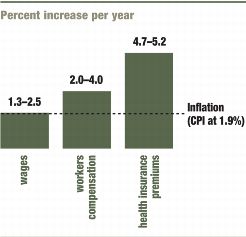Challenge
The rigidity of our current workforce structure leaves us little flexibility to adapt to changing circumstances and economic downturns.
Solution
A more flexible workforce that allows for a greater ability to reposition and reassign employees would allow us to better respond to marketplace demands.
Over the past few years we have made great progress in aligning our workforce to the lower mail volumes we are experiencing. We have been fortunate to be able to do so almost entirely through the orderly attrition of retiring workers, rather than through a disruptive process of lay-offs.
Over 39,000 career employees retired or departed on their own last year, and we are well positioned through attrition to reduce the size of our workforce at rates that match the projected future decline in mail volumes. Based on current trends we project that nearly 300,000 Postal Service career employees will become eligible to retire in the coming decade – each year we expect approximately five percent of employees will elect to retire.
However, reducing total headcount is only one part of the equation. Marketplace demands require that we have a more flexible workforce that allows for a greater ability to reposition and reassign employees. This is especially important as we consolidate our networks of mail processing facilities and realign our retail footprint.
On September 1, we began labor contract negotiations with the largest of our four unions, the American Postal Workers Union, AFL-CIO (APWU) with the goal of reaching agreement on actions to increase the Postal Service’s workforce flexibility and reduce costs. Similar negotiations with the National Rural Letter Carriers’ Association (NRCLA) began on September 13. Our past record of working successfully with labor together to help transform the Postal Service provides encouragement that we will jointly reach agreement on these important goals.
While we prefer in all cases to manage these changes through collective bargaining, under existing law, arbitration is always a possibility. Our first priority in any arbitration ruling must always be the financial health of the Postal Service and the affordability of postal products for the customers we serve. As such, we have also asked Congress to require that any arbitrator take into account our financial condition before making any decision.
As we move forward, our ultimate goal is to ensure we have the right people in the right places at the right times to deliver the products and services our customers need, where and when they need them. We are hopeful that our current discussions with our labor partners will lead us toward the realization of this critical goal.
Finally, we never for a minute forget that our employees are the Postal Service. They deliver for America with commitment, dedication and purpose, and it is to their credit that the Postal Service has met extraordinary standards of performance during the past decade, including last year.
Workforce Costs Are Expected to Rise Between 2010 and 2020
Percent increase per year

Source: McKinsey & Company analysis, IHS Global Insight

Greater flexibility in repositioning employees will drive major productivity and service improvements in the coming decade.
